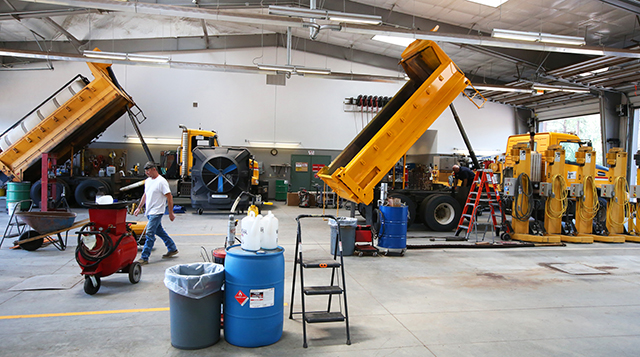Smile
Published 12:00 am Saturday, April 19, 2014

- Smile
Getting braces has always been a headache for kids — and their parents too.
But things are getting easier for detecting when a child needs braces, and new technologies are making it a more comfortable process, local orthodontists say.
Trending
We asked three local orthodontists — Dr. Cate Quas of Bluefish Dental & Orthodontics, Dr. Casey O’Neill of O’Neill Orthodontics and David Gobeille of Gobeille Orthodontics — about issues that cause parents confusion when it comes to braces. Their responses tell us one thing is clear: orthodontics has changed a lot since we were kids.
What constitutes a need for braces?
Pediatric dentists can determine a child’s eventual need for braces as early as age 1 or 2, Quas said. An early indication is the overcrowding of baby teeth in a toddler.
“If it looks like you can drive a truck in there, that’s what you want,” she said. “You can see ahead of those teeth coming in.”
Some other possible signs that a kid needs braces include: one or more of the front teeth sticking out, teeth turned sideways, under- or over-bites, excessive spacing, fangs and two rows of teeth, or “my kid looks like a shark,” Quas said.
When can your child’s dentist determine if they will need braces?
Trending
Quas recommends parents ask their kids’ dentist or orthodontist for a panoramic x-ray at age 7, which gives a clear picture of the teeth, roots and jaw, she said. The x-ray will reveal whether or not all of the permanent teeth are growing in and if they are in the correct position or orientation, she explained.
Gobeille also believes assessing kids at about age 7 gives orthodontists a more complete picture of the situation, which gives them more options and an ability to track kids over time.
“We really believe in seeing kids early, when they have lots of growth potential,” he said. “This helps avoid removing permanent teeth so they look better later on.”
Gobeille studies how a child’s teeth fit into his or her face, looks for signs of crowding, and assesses how the bite works — how the teeth work together.
At what age should you consider braces for your child?
There’s no question that kids are getting braces at a younger age than we’ve seen in the past. These days, it’s not unusual to see kids in elementary school with big metal grins accented with colorful rubber bands.
The reason for this, Gobeille explained, is that orthodontists have realized the benefit of early treatment in certain situations.
“We can change skeletal components when they’re still growing rapidly, rather than waiting until they’ve stopped growing,” he said. “If we treat a jaw issue at age 7 or 8, when 50 percent of their growth remains, well that gives us a wing and a prayer to really correct the problem.”
The two most predominant jaw issues that call for early orthodontic intervention include front to back problems – overbite and underbite, and crossbite — where one jaw is narrower than the other.
While most kids have all of their adult teeth by about age 12, the skeleton continues to grow — for girls until about age 14, and boys about age 16. Treating issues before the growth is complete not only means a shorter time period in the braces, but also tends to create more stable results, Gobeille explained.
It doesn’t mean that kids with significant problems will be done with orthodontics before they hit their teens. As many as 90 percent of early patients will have to have a second round of braces, Gobeille said.
“Early treatment gives us way better results ultimately, with almost no relapse after the second phase,” he said. “Early treatment simplifies later treatment.”
Two-phase treatment has become quite common. The first phase essentially focuses on realigning the child’s jaw, whereas the second phase is the actual straightening of the teeth.
Crowding is another issue that has a significantly better outcome when treated early.
“We can unravel that crowding and make room for teeth while the jaw is still growing,” Gobeille said. “That way we are treating without taking teeth out, which we’ve learned over the years gives us a much better smile and better profile.”
O’Neill said he is a big believer in early orthodontic treatment and finds the need for a second phase of braces is actually decreasing, and when opted for is generally more of a cosmetic fine tuning.
“Simply put, when kids are younger, the jaw bone is very flexible and isn’t fully fused in the head and neck, so there’s a much better opportunity to redirect growth,” he said. “At the stage when bone is still movable and adaptable, that redirection is much quicker and more biological. When the body thinks it did the job itself, it’s more natural and we can fix a major problem in eight months or less, and with far less relapse.”
Even kids without jaw issues can benefit from early orthodontics.
“If a front tooth is sticking out, it’s at a massive risk for traumatic injury,” O’Neill said. “The consequences for that are really big because these are the kid’s adult teeth, they’ll be with him forever.”
Alternatively, local orthodontists agree that it is not always worth getting early treatment. Each child’s case is unique and has to be assessed before a treatment plan can be outlined.
Assuming there are no crowding or skeletal problems, Gobeille waits to apply braces until around age 12 when all the permanent teeth have filled in, opting for the most efficient approach to correction. However, between the ages of 7 and 12, checking in with the orthodontist every six months is advisable.
“We like to keep the child on observation, making sure nothing goes haywire before all their teeth come in,” Gobeille said.
What’s new in the world of orthodontics?
Orthodontics has come a long way in the last five years, O’Neill said.
New imaging techniques have changed how orthodontists diagnose the need for braces, he said. Better materials also have played a huge role in the changing patient experience.
Some kids are getting the Invisalign braces, which are clear and removable. Other styles include traditional brackets, lingual brackets (on the inside of the teeth), clear brackets, ceramic brackets and a wide range of metal brackets.
There are many new trends and different styles of braces that excite parents and kids, O’Neill said. These days, braces just aren’t causing as many headaches.
For more information, visit the American Association of Orthodontists’ website at www.braces.org.








